Blackpool Tramway
| Blackpool Tramway | |
|---|---|
_tram_at_Tower_tram_stop.jpg) Tram No. 011 at Tower tram stop | |
| Operation | |
| Locale | Blackpool, England |
| Open | 1885 |
| Status | Open |
| Lines | 1 |
| Routes |
|
| Owner(s) | Blackpool Council |
| Operator(s) | Blackpool Transport |
| Infrastructure | |
| Track gauge | 1,435 mm (4 ft 8 1⁄2 in) standard gauge |
| Electrification | 600V Overhead lines |
| Stock | |
| Statistics | |
| Route length | 11 mi (17.7 km) |
| Stops | 38[1] |
| Passengers (2017/2018) |
5.2 million [2] |
| Website |
[www www |
| Part of a series of articles on |
| Blackpool Tramway |
|---|
| Blackpool Tramway |
|---|
The Blackpool Tramway runs from Blackpool to Fleetwood on the Fylde Coast in Lancashire, England. The line dates back to 1885 and is one of the oldest electric tramways in the world.[6] It is operated by Blackpool Transport (BTS) and runs for 11 miles (18 km). It carried 5.2 million passengers in the 2017/18 financial year.[2]
It is the last surviving first-generation tramway in the United Kingdom, though the majority of services on the line have since 2012 been operated by a fleet of modern Flexity 2 trams. A 'heritage service' using the traditional trams operates on Bank Holidays, select weekdays and weekends from January to December, as well as during the Blackpool Illuminations. Excluding museums, it is one of only a few tramways in the world to still use double-deck trams, others including the Hong Kong Tramways and the Alexandria Tram in Egypt.
History
The first part opened on 29 September 1885, a conduit line from Cocker Street to Dean Street on Blackpool Promenade.[7] It was one of the first practical electric tramways in the world, just six years after Werner von Siemens first demonstrated electric traction. The inauguration was presided over by Holroyd Smith, the inventor of the system and Alderman Harwood, the Mayor of Manchester.
It was operated by the Blackpool Electric Tramway Company until 1892 when its lease expired and Blackpool Corporation took over. A line was added in 1895 from Manchester Square along Lytham Road to South Shore, extended to South Pier with a line on Station Road connecting Lytham Road to the promenade in 1897.[7]
Conduit operation, in which trams took electricity from a conduit below and between the tracks, though very successful in locations such as town or city centres, proved to be very problematic on a line so close to the coast. During bad weather, sea water washed over the track and into the conduit where it short circuited the traction supply and operated the circuit breakers in the power station. Sand from the beaches was blown across the tracks and filled up the conduits. It was constantly necessary to remove this sand, as the addition of sea water would leave the conduits filled with wet sand which short circuited the supply. Another problem was that electrical resistance was greater than anticipated and the voltage in portions of the conduit was far less than that generated at Blundell Street – 230V dropped to 210V at the junction with the main line on the Promenade, 185V at Cocker Street and 168V at South Pier (then Victoria Pier).
In 1899 550V overhead wiring was installed and the conduit removed. In 1900 the line was extended north to Gynn Square where it linked up with the Blackpool and Fleetwood Tramroad. In 1901 the Marton loop was opened, connecting Talbot Square and Central Station along Church Street, Devonshire Square, Whitegate Drive, Waterloo Road and Central Drive. A new depot was built on Whitegate Drive in Marton. A line was added from Talbot Square along Talbot Road to Layton in 1902. By 1903 the promenade line had reached the Pleasure Beach.[7]
In 1920 Blackpool Corporation took over the tramroad, gaining eight miles (13 km) of track and three depots, two in Fleetwood and one in Bispham. The small Bold Street Depot in Fleetwood was closed and a loop constructed at Fleetwood Ferry.[7] Blackpool Corporation also gained all 41 trams from the tramroad.
A larger depot site was developed on Rigby Road in 1920 due to the original Blundell Street Depot having become too small. Rigby Road Depot was built in 1935. Along the line to Fleetwood, between Rossall and Broadwater a more direct line was built in 1925. The final tramway extension was in 1926, along the promenade to Clifton Drive at Starr Gate where a connection was made with Lytham St. Annes Corporation Tramways.[7]

In the 1930s manager Walter Luff, as part of a five-year plan for modernisation, introduced a fleet of modern streamlined tramcars including the enclosed Railcoaches, the single-deck open-topped Open Boats and the English Electric double-deck Luxury Dreadnoughts (later known as 'Balloons'). These formed the backbone of the fleet into the 21st century. In 1936 route closures began with the Central Drive and Layton routes. Lytham Road closed in 1961, Marton in 1962 and the tramroad line on Dickson Road to North Station in 1963. Marton and Copse Road Depots closed in 1963 and Bispham Depot in 1966. This left the line from Starr Gate to Fleetwood, which remains. Blackpool Borough Council transferred the operation of the tramway and buses to Blackpool Transport Services Limited in 1986.[7]
Blackpool was the only town in the UK that retained its trams and between 1962 and 1992 it had the only urban tramway in the UK.[8] The last English city to lose its conventional trams was Sheffield in 1960. The last in the UK was Glasgow in 1962. The 1992 opening of the Metrolink in Manchester heralded a revival.[8]
During the 1970s, the tramway was struggling to remain open, so one-person-operated tramcars were developed in order to reduce costs. This included rebuilding older tramcars into the OMO cars and Jubilee cars followed by the purchase of the Centenary cars.

Another innovation during the 1970s was the application of all-over adverts on tramcars to increase earnings. Advertising on Blackpool tramcars first appeared on the Conduit cars in the early years of the tramway, with upper deck decency panels utilised for this purpose. Some trams such as the Blackpool and Fleetwood Racks and Boxes had side panels fitted to the roof for advertising purposes. Various trams have since had adverts applied on the cab-ends and sides upon their liveries. In 1965, Coronation tram No. 310 was fitted with illuminated advert panels at the cab ends on the roof. This was followed by larger rectangular boxes in the 1960s on various Coronations, English Electric Railcoaches, Brush Railcoaches and OMO trams and remained a feature on some of them until the mid 1990s. In 2010, Brush Railcoach tram No. 632 had new advertising boxes fitted to recreate this feature. All-over adverts first appeared in 1975. Balloon tram No. 707 was the first tram to carry an all-over advert for Empire Pools. Brush Railcoach tram No. 622 was the first single-deck tram to carry an all-over advert for Blackpool Zoo in 1975. The English Electric Railcoaches, Brush Railcoaches, OMO trams and Centenary trams which carried adverts had their towers panelled over to provide more space for advertising. Various all-over adverts have since appeared on several tramcars.
Following the Government's pledge in 2000 to build 25 new tram networks by 2010,[9] a £1 billion bid for a Government grant was launched by Blackpool Council and Lancashire County Council in 2002 to expand the tram network to St. Annes to the south and new housing estates in Fleetwood to the north, with a possible further phase to Poulton-Le-Fylde and Thornton. In 2004 campaigners behind the bid expressed disappointment that nothing had been done to take the plans forward in two years. By November 2007 there was no further development.[10]
For the first time the entire tramway was closed in November 2007 for five months of essential repair work, the second phase of an £11.8 million upgrade.[11] In January 2007 the City Class 611 prototype "supertram" was being tested on the tramway when it caught fire as it approached Central Pier, causing extensive damage.[12] The driver escaped when the electrical console in the cab reportedly blew up. The tram, manufactured by Merseyside based Tram Power, was being tested as part of a bid to replace the current trams.[13] The tramcar was rebuilt at a cost of £150,000 but was not permitted to resume trials; it is currently scheduled to form part of a trial park & ride tram line in Preston. The same tram had derailed on 30 May 2006 at Starr Gate loop during previous trials. A Rail Accident Investigation Branch report stated that the derailment was due to wear and tear on the track with a contributory factor being the new type of running gear on the tram.[11]
On 1 February 2008 it was announced that the Government had agreed to the joint BTS and Blackpool Council bid for funding toward the total upgrade of the track. The Government were to contribute £60.3M of the total £85.3M cost. Blackpool Council and Lancashire County Council would each provide about £12.5M. The Government's decision meant that the entire tramway was upgraded and 16 Flexity 2 trams replaced the fleet in 2012.[14]
The tramway resurfacing works and construction of a tram shed at Starr Gate meant no trams operated south of the Pleasure Beach from 2009 until the new trams entered service in April 2012 and track work at Cleveleys halted services north of Little Bispham. A replacement bus service operated.
In 2011 the line voltage was raised to 600V in anticipation of the arrival of the new rolling stock. 6 November 2011 marked the last day of running for the traditional tram fleet. The tramway reopened on 4 April 2012 with Flexity 2 cars providing day to day services.[15] Some of the traditional fleet has been retained and some of them have been restored, with unmodified trams being part of the 'Heritage Fleet' and modified, widened Balloon trams as part of the main fleet. The depot at Starr Gate houses the Flexity 2 fleet. Rigby Road Depot, near Manchester Square, is where the traditional trams are kept. Much work has been put in to make sure that the traditional trams have a safe future in Blackpool.
Blackpool Tramway today
_tram_at_Tower_tram_stop.jpg)

Trams run from Starr Gate in the south to Fleetwood in the north. Some services, especially in busy periods such as during Blackpool Illuminations or on bank holidays, start or terminate short at Cleveleys, Little Bispham, Bispham, or the Pleasure Beach to allow a more intensive service through the centre of Blackpool. During the Illuminations, decorated trams carry passengers on the promenade along the illuminated area, running from Pleasure Beach to Bispham.[16]
The Flexity 2 trams now operate main services, with modified Balloon double-deck trams available if necessary. Unmodified, traditional trams provide a 'heritage service' on select weekdays, weekends, bank holidays and summer months, as well as operate on tours during the illuminations.[15] They stop only at special 'heritage stops' next to normal tram stops at Pleasure Beach, North Pier, Cabin, Bispham, Cleveleys and Fleetwood Ferry.[17] Temporary 'heritage stops' are also used for the traditional trams during select special events, such as at Starr Gate.
| From | To | Frequency | Days | Operated By |
|---|---|---|---|---|
| Starr Gate | Fleetwood Ferry | Every 10 to 15 minutes daytime* | Mon–Sun (inc. B/H) | Flexity 2 |
| Pleasure Beach | North Pier/Cabin (Fleetwood on B/H and special days) | Up to 20 minutes on running days | Limited winter weekends and every weekend from March–November (inc. B/H) and during Blackpool Illuminations | Heritage |
*Regularity is dependent on season and/or time of day.[18]
The network
The tramway runs from Starr Gate in Blackpool to the Ferry Terminus in Fleetwood, mostly along the Fylde Coast sea front, turning inland at Cleveleys for the last few miles before ending at the coast in Fleetwood. The tracks consist of four different types:
- Street running, open to all traffic – along Lord Street and North Albert Street in Fleetwood. There is also a stretch in Blackpool from Rigby Road Depot to the Promenade along Hopton Road and Lytham Road used for trams entering and leaving service only. A short stretch on the Promenade in Blackpool behind the Metropole Hotel used to be in this form, but when the whole tramway was relaid in 2011 it was converted to Paved (see below). The new line to Blackpool North station is expected to also be in this form.
- Paved reserved track alongside a road, open to pedestrians but not road traffic – along most of the route between Starr Gate and Cabin.
- Reserved ballasted track, open to trams only – from Cabin to Rossall and along Radcliffe Road in Fleetwood.
- Interurban style, not following a road and open to trams only – from Rossall to Radcliffe Road, Fleetwood.
There are four loops, at Starr Gate (although not generally used during service), opposite the Pleasure Beach, Little Bispham and Fleetwood, as well as links to Rigby Road Depot.[19]
The tramcars are powered by 600V overhead wire with electricity transmitted to the tramcars by pantograph and a few vintage trams by trolley pole.[20]
Fleetwood Transport Festival
Each year the Fleetwood Transport Festival, known locally as Tram Sunday,[21] is held on the third Sunday in July. It celebrated its 21st anniversary in 2005.[22] It attracts thousands of visitors[21] and takes place on the full length of the main street, Lord Street. There are vintage tram rides from Fishermans Walk to Thornton Gate.[16][23] In 2007, the festival, despite its popularity, was nearly cancelled due to a lack of support organising the day.[21] A last-minute appeal for help resulted in the festival being saved.[24]
Future

An extension of the tramway along Talbot Road to Blackpool North railway station is under construction. Enabling work began on 6 November 2017[25] and the link is expected to open in 2019.[26] A new tram terminal will be provided as part of the project.[27]
A feasibility study is currently being undertaken regarding a further extension to Lytham St Annes.
Popular culture
In 1989, Alan Bradley, a character in the soap opera Coronation Street, was killed when he was hit by Bispham bound tram 710 outside the Strand Hotel on North Promenade.[28]
Tram depots
There have been seven depots:
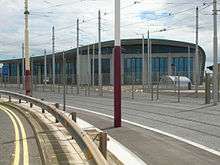
- Bispham Depot was built in 1898 and extended in 1914 by Blackpool & Fleetwood Tramroad Company, to house 36 trams on six tracks. A substation was built to the side of the depot. The depot was used to receive pantograph cars in 1928 and Brush Railcoach cars in 1940. It closed on 27 October 1963 and was used as a store until the mid-1970s. It was demolished to make way for a Sainsbury's supermarket and the depot's headstone was installed at Crich's National Tramway Museum.
- Bold Street Depot opened in January 1899 and had a capacity of 4 cars on two tracks. It was used only by the last two trams to Fleetwood in the evening and the first two trams in the morning. After Blackpool Corporation took over the tramroad in 1920, the depot was closed. Wires were taken down in 1924 when the Fleetwood loop was built. After World War II the depot was used by Fisherman's Friend. It was demolished in 1973 to make way for flats.
- Blundell Street Depot opened in 1885 to house 10 conduit trams. It was extended in 1894 and 1896 and in 1898 when the roof was raised to accommodate overhead wiring. After extension, the depot housed 45 trams on five tracks. The depot became a store in 1935 when the new central depot opened at Rigby Road. The inspection pits were filled in after World War II and after 1956 the building was used as a bus garage. The depot was reopened for trams in March 1963 after the closure of Marton depot. A new entrance was built in July 1964 but capacity was restricted by the presence of an ambulance station in the building. Following damage to the central roof caused by a gale, the depot was demolished on 4 November 1982.
- Copse Road Depot was built in 1897 by the Blackpool & Fleetwood Tramroad Company with six tracks, capable of housing 18 trams. It was originally used as a store and service depot. After passing to Blackpool Corporation Tramways it was used to dismantle old trams. Between 1925 and 1949 a line connected the depot with the railway and was used to shunt wagons. After Blackpool Corporation sold the depot, it was used as a car showroom. The substation still fed the Fleetwood line section during this time. The depot was demolished in 2016 after a scheme to convert the building into a tram museum failed, due to the poor condition of the building.[29]
- Marton Depot was built in 1901 to accommodate 50 trams. It was used for central routes but declined in use after the closure in 1936 of the Layton and Central Drive sections. It closed for tram use between 1939 and 1944 due to World War II and accommodated aircraft of the Vickers Aircraft Company. It closed on 11 March 1963, with the last car to leave being Standard car No. 48. The front half was demolished with the rear half in commercial use. A petrol station is now on the site.
- Rigby Road Depot was built in 1935 and is still in use. It has a capacity of 108 trams. It was designed to replace the Bispham and Blundell Street depots and has been modernised several times. In 1955 tracks 15 to 18 were enclosed by a partition to be used as an electrical compound and in 1962 a tram-washing plant was built, along with the replacement of the roller-blind doors by folding aluminium doors. It has also been used to house some buses.
- Starr Gate Depot was built during 2011 as part of the complete network refurbishment and cost £20M. It officially opened in Easter 2012 and is fully operational. It has a maximum capacity of 20 articulated trams. It was built to house the first 16 Flexity 2 trams, including an additional 2 added to the fleet in 2017. An expansion with a public attraction to display heritage units was planned when Rigby Road Depot was due to be disposed of, but was not built, with Rigby Road Depot being retained for the heritage trams.[30]
Tramcar fleet
The tramway has a varied fleet. The standard livery introduced on the Flexity 2 trams has purple fronts, with white sides, black window frames and a purple criss-cross pattern on the lower sides. The heritage tramcars mostly use the traditional green and cream livery of BTS in various styles from the 1930s to the 1990s, with some older cars using the older red and cream/ white liveries and teak and cream livery. Some trams carry colourful all-over advertisements.[20]
The Rail Vehicle Accessibility Regulations have seen the fleet divided into three parts: the 'A' fleet of 18 Flexity 2 trams, fully compliant with the RVAR; the 'B' fleet of 9 converted double-deck trams that have partial exemption through partial conversion to improve accessibility; and the 'C' fleet, the exempt heritage fleet.[31]
The operational fleet from 4 April 2012 is:
| Class | Image | Top speed | Number | Built | |
|---|---|---|---|---|---|
| mph | km/h | ||||
| Flexity 2 | .jpg) |
43 | 70 | 18 | 2010–2017 |
| Balloon Cars | 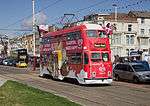 |
43 | 70 | 9 | 1934–1935 (refurbished 2009–2012) |
Flexity 2

As part of the upgrade, 16 Flexity 2 trams were ordered[32] and were numbered 001-016. The worldwide launch of the tram including showing the first new tram occurred on 8 September 2011 at the new Starr Gate depot.[33]
These state-of-the-art trams include many improvements, such as 100% step-free access from platform to tram, dedicated wheelchair spaces, higher seating and standing capacity, faster acceleration and quieter running. They have audio-visual 'next stop' displays.
The trams are accommodated at the new depot built at Starr Gate by VolkerFitzpatrick.[34]
Two further Flexity 2 units, numbered 017 and 018, arrived on 1 and 15 December 2017 respectively after being ordered to assist with service demands when the extension to Blackpool North railway station opens.[35][36] They entered service on 4 March 2018.[37]
Modified 'Balloon' double-deck cars
Nine of the Balloon cars from the heritage fleet, numbered 700, 707, 709, 711, 713, 718, 719, 720 and 724, were modified (including widening of the platforms) between 2009 and 2012, so that they are able to operate on the modified tramway in a full service as extra capacity cars during peak times and in case of any incidents that might prevent the Flexity 2 trams from operating.
Heritage trams
Blackpool has an extensive history of tramcars. In addition to the Flexity 2 trams and modified B-fleet cars, there is large fleet of vehicles that were retained from previous generations of the town's tramway operations, as well as some from other locations, that are now operated by Blackpool Heritage Tram Tours.
Tram classes
Conduit cars
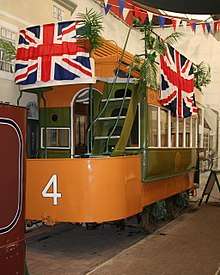
The Blackpool Tramway opened on the 29 September 1885 with an initial fleet of 10 trams. The first eight were double deck open top trams that operated on the conduit system, whilst the ninth and tenth cars were single deck crossbench trailers which would be hauled by any of the first eight trams. The original fleet livery was sand, green and white. The trams were built in various conditions. Nos. 1 and 2 were built by Starbuck, with 48 seats and a garden seating arrangement on the upper decks. Nos. 3 and 4 were built by Lancaster Carriage and Wagon Works, with 32 seats and a knifeboard seating arrangement on the upper decks. Nos. 5 and 6 were also built by Lancaster and had a knifeboard seating arrangement on the upper decks, but they had a higher seating capacity of 44. Nos. 7 and 8 were built by Starbuck, with 56 seats and a crossbench seating arrangement on the upper decks. Nos. 9 and 10 were built by Lancaster with 28 seats in a crossbench seating arrangement. In 1891, the two trailer cars were replaced by two new double deck open top Conduit cars which were given the same numbers. The new 9 and 10 were built by G.F. Milnes, with 48 seats and a garden seating arrangement on the upper decks, just like nos. 1 and 2. Conduit car No. 4 is preserved by the National Tramway Museum in Crich.
Lancaster Palace cars
The Lancaster Palace cars were 4 trams built between 1894-1896. They were numbered 11-14. They were the first trams in Blackpool to have two bogies each rather than four wheels fixed in place under the bodies.
Dreadnought cars
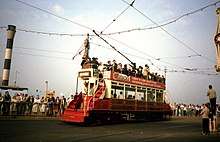
The Dreadnought cars were 20 trams built between 1898-1902 by G.F. Milnes. They were numbered 15-26 and 54-61. The design was unique to the Blackpool Tramway, with double staircases fitted at each end to access the upper decks whilst the driving compartments and access to the lower decks were in between the staircases. The sole surviving member of the class, Dreadnought car No. 59, is preserved by the National Tramway Museum in Crich.
Marton Box cars
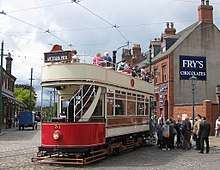
The Marton Box cars were 15 open-top trams built in 1901. They were numbered 27-41. They were later rebuilt with enclosed upper decks. The sole surviving member of the class, Marton Box car No. 31, has been on a long term loan at the Beamish Museum since 1984.
Motherwell cars
The Motherwell cars were 12 open-top trams built in 1902. They were numbered 42-53. They were later rebuilt with enclosed upper decks. When they were all scrapped, they donated their top covered decks to the Standard cars.
De-Luxe cars
The De-Luxe cars were 7 trams built in 1911. They were numbered 62-68. There were initially two variants of this class, where 62-64 were built as 4 wheeled tramcars, whilst 65-68 were built as bogie tramcars. 62-64 were altered to have bogies by 1923. De-Luxe car No. 68 was decorated several times from 1912 with garlands and lights for various occasions. No. 68 was withdrawn in 1936 and scrapped in 1939.
Toastrack cars
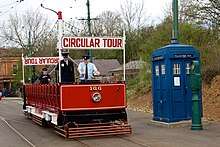
The Toastrack cars were 30 trams built between 1911-1927. They were numbered 69-92 and 160-165, with No. 160 later being renumbered as No. 166 so that Standard car No. 160 could be numbered consecutively alongside Standards 142-159. They were named as Toastracks after the tableware item which holds toast. After being withdrawn from passenger service, Nos. 165 and 166 were converted between 1951-1953 for use on television filming assignments on the tramway. Toastrack car No. 163 was rebuilt in 1959 as the illuminated Blackpool Belle and after initially operating without a number in this form, it was renumbered 731 in 1968. The sole surviving member of the class, Toastrack car No. 166, is preserved by the National Tramway Museum in Crich.
London cars
The former London United Tramways X class cars were 6 trams built in 1901 by G.F. Milnes and purchased for use on the Blackpool Tramway in 1919. They were originally numbered 108, 118, 125, 137, 149 and 150 in the London United Tramways fleet. They were renumbered 93-98 in the Blackpool tram fleet.
Fleetwood Box cars
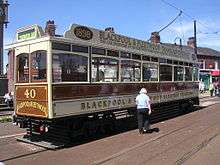
The Fleetwood Box cars were 15 trams built between 1898-1914 by G.F. Milnes. They were originally numbered 14-24 and 38-41 in the Blackpool and Fleetwood Tramroad fleet, before being renumbered 101-115 after being purchased by Blackpool Corporation Transport in 1920. Box cars 20-24 became 101-105, Box cars 14-19 became 106-111 and Box cars 38-41 became 112-115. The last four cars were built without clerestory roofs and were known as New Fleetwood Box cars. Box car No. 40 (114) is preserved by the National Tramway Museum in Crich, but has been on a long term loan since 1996 to the Blackpool Tramway.
Fleetwood Yankee cars
The Fleetwood Yankee cars were 7 partially open-sided combination trams built in 1899 by the Electric Railway and Tram Carriage Works (ER&TCW). They were originally numbered 28-34 in the Blackpool and Fleetwood Tramroad fleet, before being renumbered 116-122 after being purchased by Blackpool Corporation Transport in 1920. Apart from No. 30 (118), they were rebuilt with enclosed saloons between 1920-1921 and became known as Greenhouse cars and Glasshouse cars.
Fleetwood Vanguard cars
The Fleetwood Vanguard cars were 3 trams built in 1910 by United Electric Car Company. They were originally numbered 35-37 in the Blackpool and Fleetwood Tramroad fleet, before being renumbered 123-125 after being purchased by Blackpool Corporation Transport in 1920. OMO car No. 7 was rebuilt as a replica Vanguard car in 1987 and was renumbered 619, its previous number when it was an English Electric Railcoach prior to its rebuild as an OMO car. It is preserved by the Heaton Park Tramway in Manchester.
Fleetwood Crossbench Rack cars
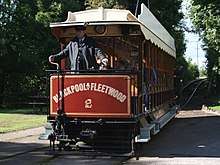
The Fleetwood Crossbench Rack cars were 16 open-sided trams built between 1898-1899 by G.F. Milnes. They were originally numbered 1-13 and 25-27 in the Blackpool and Fleetwood Tramroad fleet, before being renumbered 126-141 after being purchased by Blackpool Corporation Transport in 1920. The Crossbench Rack cars were 1-10 (126-135) and 25-27 (139-141) and the trailer cars were 11-13 (136-138). The trailer cars were later converted to motor cars. Rack car No. 2 (127) is preserved by the National Tramway Museum in Crich.
Standard cars
_(9126081372).jpg)
The Standard cars were 42 trams built between 1923-1929 by the Blackpool Corporation Transport Department and Hurst Nelson in Motherwell. They were numbered in-consecutively, with the numbers being 28, 33-43, 45-51, 53, 99-100, 142-160 and 177. The Standard cars with the numbers 28, 33-43, 45-51 and 53 reused those numbers from the Marton Box and Motherwell trams that had been withdrawn. They are double deck, originally with open balconies and have a capacity of 78 passengers, with 32 seats on the lower deck and 46 on the upper. The four-window design came from the 1902 Motherwell trams. They are 33 ft 10 in (10.31 m) long, 16 ft 7 in (5.05 m) high and 7 ft 2 in (2.18 m) wide. They had Preston McGuire bogies with 4 ft 1 in (1.24 m) wheelbase and 30 in (760 mm) diameter wheels, BTH B510 motors with hand and rheostatic brakes. All were built as the "open balcony" type, but in later years some were enclosed. The Standard cars were originally in service between 1923 and 1966, with the withdrawal of the Standards being protracted from 1940. Standard car No. 40 became the last double-deck open balcony tram to operate commercially in Great Britain. Until 2002, no Standards survived in public service in Blackpool until Boat car No. 606 was given to the Trolleyville museum in the United States in 2000 in exchange for Standard car No. 147, which has been restored to its enclosed condition and returned to service in April 2002. 147 was on loan to Beamish Museum for a year from March 2016 and returned to Blackpool on 15 March 2017.
Seven Standard cars were preserved. Nos. 48, 49, 147 and 159 have been restored to enclosed condition and have the green and cream livery. Nos. 147 and 159 remain operational, at Blackpool and the East Anglia Transport Museum respectively, whilst No. 49 is awaiting a major overhaul at the National Tramway Museum at Crich. Standard car No. 40 is in near original condition with open balconies on the upper deck and is enclosed on the lower deck. Standard car No. 143 is in its original open balcony form. No. 40 is in operational condition at Crich whilst 143 is in Blackpool awaiting the completion of its restoration. Both trams are painted in red, teak and cream. Two Standard cars are preserved in the United States. No. 144 is at the Seashore Trolley Museum in Maine and retains its open balconies on the upper deck with the lower deck enclosed.[38] No. 48 has been in the Oregon Electric Railway Historical Society collection since 1964[39] and has enclosed balconies. It operated on the Willamette Shore Trolley heritage tramway in Portland between 1995 and 2006 and then returned to the Oregon Electric Railway Museum,[40] where it returned to service in 2017.[41] Both Nos. 48 and 144 are in the green and cream livery.
Pantograph cars
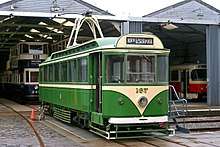
The Pantograph cars were 10 trams built in 1928 by English Electric in Preston. They were numbered 167-176. These cars were single-deckers and purchased at a cost of £2,000 (equivalent to £110,587 in 2016),[42] by Blackpool Corporation Tramways. They were designed for interurban use and have an American style appearance with 48 seats. Originally given the nickname "Pullman" cars due to their more luxurious assets, they were the first trams in Blackpool to be equipped with a pantograph built by Brecknell, Munro & Rogers mounted on a tall tower, which very quickly earned them the longer-lasting nickname "Pantographs". They were subsequently fitted with traditional trolley poles. The first car, No. 167, was delivered on 30 July 1928 and the last, No. 176, in 1929. They were 40 ft (12 m) long and 7 ft 6 in (2.29 m) wide, had Dick Kerr bogies, BTH B510 motors and air-brakes, with hand and rheostatic brakes.
The sole surviving true member of the class, No. 167, is preserved at the National Tramway Museum in Crich. It returned to Blackpool for the 100th and 125th anniversary celebrations in 1985 and 2010, in 1998 for the 100th anniversary of the Blackpool and Fleetwood Tramroad and for a short loan period during Summer 2014. Three ex-Pantograph cars survive as illuminated cars: No. 174 is still recognisable as the trailer to the illuminated Western Train, which received a £278,000 Heritage Lottery Fund grant for restoration and is part of the heritage fleet. No. 170 formed the basis for the illuminated Frigate in 1965 and still resembled a Pantograph car from the back end, until it was rebuilt again in 2004, altering its appearance and removing the last remnants of its Pantograph car shape. No. 168 formed the basis for the illuminated Rocket which was withdrawn from service in 1999 and stood derelict at Rigby Road Depot[43] until 2012 when it was cosmetically restored and displayed as a static exhibit as part of the Illuminations. It has since returned to Rigby Road Depot for storage and eventual restoration as an operational tram within the heritage fleet.
English Electric Railcoach cars
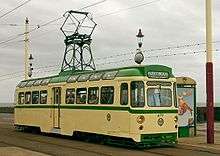
The English Electric Railcoach cars were 45 streamlined enclosed single deck trams built by English Electric between 1933-1935. They were numbered 200-224 and 264-283. None of these remained in their original form, with 10 cars (272-281) rebuilt as towing cars for the Progress Twin Set cars in the 1950s and 1960s, 2 cars rebuilt as illuminated cars in the 1960s (209 as the Western Train Locomotive and 222 as the Hovertram), No. 264 rebuilt in 1964 with flat cab-ends and rounded corners, No. 618 (271) rebuilt in 1968 with tapered cab-ends and the last 11 surviving cars as well as Nos. 264 and 618 (220-221, 224, 264-271 and 282-283) rebuilt as the One-Man Operated (OMO) cars in the 1970s. The other 20 cars were scrapped.
English Electric Railcoach car No. 264 was rebuilt in 1964 with flat cab-ends and rounded corners, resembling the Coronation cars and the Twin Set cars. No. 264 was also given exterior plastic panelling to reduce its weight, but was returned to aluminium panelling due the plastic warping and becoming discoloured. No. 264 became No. 611 in 1968. English Electric Railcoach car No. 618 was rebuilt in 1968 with tapered cab-ends, increasing its capacity from 48 to 56. Prior to being rebuilt as the OMO cars, the last 11 cars remaining in their original form, as well as Nos. 264 and 618 (271) were renumbered in 1968: 220-221 became 608-609, 224 became 610, 264-271 became 611-618 and 282-283 became 619-620.
The former Twin Set towing cars 678–680 (278-280) were converted back to single trams with cabs at both ends. English Electric Railcoach tram No. 679 was given an all-over advert for Mecca Bingo in 1994, which featured two big fibreglass bears fitted to the roof, with one on each end. The advert and fibreglass bears were removed in 1995. The last of these in the active fleet, No. 680, was withdrawn in 2008. 678 was preserved by Fleetwood Heritage Leisure Trust in 2011. 679 was preserved by the Lancastrian Transport Trust until 2013, when it joined the retained heritage fleet in Blackpool and will eventually be restored into original condition and regain its original pre-1968 number of 279. 680 was preserved at the Heaton Park Tramway in Manchester in 2011. During December 2013, 680 was transferred to Beamish Museum for an operational loan deal and entered service there. In April 2015, No. 680 was transferred to its permanent home at Heaton Park Tramway and entered service there. In August 2015, No. 680 was transferred to Blackpool for an initial 2-year loan and was repainted into 1990s green and cream livery with black window surrounds.
Boat cars
| Boat car[44] | |
|---|---|
.jpg) Open Boat car No. 600 by Trafalgar Road | |
| Constructed | English Electrics 1934 |
| Capacity | 52–56 Passengers (Seated) |
| Specifications | |
| Width | EE 4 ft (1.2 m) wheelbase |
| Power output | 2xEE 327, 40 hp (30 kW) |
| Power supply | 2xEE 327, 40 hp (17.5 kW) |
| Track gauge |
4 ft 8 1⁄2 in (1,435 mm) |
| Controller |
600, 607: 2xEE DB1 602, 604, 605: 2xEE Z type 603 (228): 2xEE B18 |
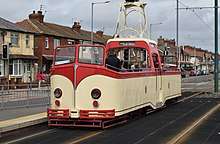
The Boat cars were 12 single deck open-topped trams with central doors and gangway built by English Electric in 1934. The Boat cars, originally called Luxury Toastrack cars, were commissioned by Walter Luff in 1933, in accordance with his five-year plan. The prototype arrived in Blackpool in January 1934. After an initial trial period, company directors approved an order for 11 production cars, which arrived in July and August 1934.[44] They first appeared with the 1930s style green and cream livery. They were originally numbered 225-236, with eight surviving cars being renumbered 600-607 in 1968.[45]
The prototype was numbered 225, with the first production car being numbered 227, due to the first Balloon car being numbered 226, as that car had arrived with number 225 in Blackpool before the production Boat cars. The second to tenth production cars were numbered 228-236. The first Balloon car was renumbered 237 to fit the number sequence of the Balloon cars after the number sequence of the Boat cars. The eleventh production car was therefore numbered 226. The Boat cars have a passenger capacity of between 52 and 56. They became better known as "boats" than "Luxury Toastracks" due to their ship-like streamlined appearance and are one of the most iconic Blackpool tram types. All cars are virtually identical except for the prototype 600, which has shorter body panels.[46]
Work began on the circular and coastal tours, replacing the original Toastrack cars, which were considered dangerous and old-fashioned. They were stationed at both Rigby Road and Marton depots for ease of access and continued there until the outbreak of World War II, when they were stored out of service due to the withdrawal of the circular tour and general lack of demand. This continued until 1946, when they returned to work on the promenade service.
They remained in regular service until the closure of the inland routes during 1963.[46] The fleet was reduced to eight and renumbered 600–607, with 229, 231, 232 and 234 being mothballed and scrapped in 1968.
The fleet was further reduced in the 1970s. Car 601 (226) was the first to be preserved and has been at the Western Railway Museum, Suisun City, California, United States, since 1971, renumbered back to its original pre-1968 number of 226. Car 603 (228) was loaned to Philadelphia in 1976 for the United States Bicentennial, then returned to Blackpool where it was stored until 1984, when it was given to the San Francisco Municipal Railway (MUNI), where it is still operated with its original pre-1968 fleet number of 228.[43][47]
In the 1990s the six remaining boats were refurbished and received new liveries, including 1930s green and cream for 600, black and yellow for 602, AEC Routemaster red and white for 604, a fictitious wartime livery for 605, blue and yellow for 606 and green and yellow for 607.[48]
The fleet was further reduced when car 606 was given to the Trolleyville Museum, Ohio, United States, in September 2000, in return for Standard 147, which was restored to its enclosed condition.[43][49] Following the closure of the Trolleyville museum, 606 was sold to the National Capital Trolley Museum, in Maryland.[50]
During 2009–2010, 600 underwent a major overhaul and rebuild, the first Boat to undergo such high maintenance. Work included the fitting of modern safety features such as halogen headlights and a rubber bumper and fibreglass skirt on each end. This tram carries the original 1930s green and cream livery.
In 2012, 607 moved to its new home at the National Tramway Museum in Crich following restoration in Blackpool and is in regular service, repainted in 1950s green and cream livery and renumbered back to its original pre-1968 fleet number of 236.
In June 2012, 604 returned to service repainted in 1970s green and cream livery with sponsorship from the George Formby Society. It was named "George Formby OBE" and renumbered back to its original pre-1968 fleet number of 230.
In August 2013, 602 returned to service repainted in a fictitious style of Blackpool Corporation red and cream livery and was renumbered back to its original pre-1968 fleet number of 227.
In October 2013, car 605 (233) was delivered to MUNI and renumbered back to its original pre-1968 number of 233 to supplement car 228.[51]
Balloon cars
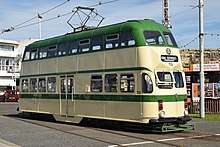
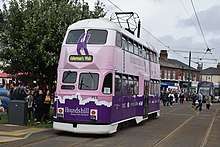
The Balloon cars were 27 cars built by English Electric between 1934 and 1935, the first thirteen to an open top design and the last fourteen to an enclosed design. The first Balloon car was numbered 226 but was renumbered 237 to fit the number sequence of the Balloon cars after the Boat cars. They were numbered 237-263 and renumbered 700-726 in 1968. All the open topped cars were enclosed during World War II, but one has since been restored to an open topped car (706). A number of them have since been rebuilt in various conditions to modernise and improve the usefulness of the cars, with 700, 707, 709, 711, 713, 718, 719, 720 and 724 added to the 'B' fleet. Balloon cars 701, 703, 704, 706, 715, 717 and 723 were retained or returned to the tramcar collection for use within the heritage fleet.
Brush Railcoach cars
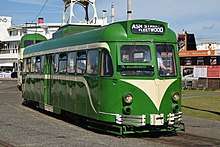
The Brush Railcoach cars were 20 trams built by Brush in 1937. These are single-deck cars that closely resemble the original English Electric Railcoaches, but have more pointed ends. They were originally numbered 284-303, with eighteen survivors being renumbered 621-638 in 1968 (301 and 303 were scrapped without being renumbered). No. 638 was experimentally converted as a driver-only operated tram in 1969 with doors built at the ends for entry, but the experiment was deemed a failure due to the layout and seating capacity reduction, so No. 638 was converted back into a conventional Brush Railcoach. No. 638 was withdrawn from service in 1980 requiring an overhaul, but was scrapped in 1984 after being deemed surplus to requirements. No. 629 was withdrawn in 1972 requiring an overhaul, but was scrapped in 1980 due to Rigby Road workshops working throughout the 1970s on the OMO rebuild programme. No. 628 was withdrawn in 1969 due to a collision with Balloon car No. 726. The body of No. 628 was scrapped, but the underframe was converted into a rail carrying trailer with a rail crane installed. No. 628 was renumbered 751 and then 260. No. 633 was given an all-over advert for The Post Office in 1982, which featured a sales stand in one of the saloons where stamps and postcards could be bought and posted on board. The advert and sales stand were removed in 1984. No. 633 was later rebuilt as the illuminated Trawler in 2001 and renumbered 737 in 2008.[20] One Brush car, No. 631, was retained by Blackpool Transport for the heritage fleet and has been restored to its 1950s condition. Although its restoration has not yet been completed and some features of its 1990s rebuild remain, No. 631 re-entered service in May 2013. No. 622 was given to Anchorsholme Primary School for use as a static classroom. No. 626 was sold to Peel Holdings. No. 636 was sold to Stored Energy Technology to test experimental equipment. All of the other Brush Railcoach cars were acquired for preservation due to the modernisation of the tramway in 2011-2012.
In December 2013, former Permanent Way car No. 259 (originally No. 287, then No. 624, then Permanent Way car No. 748) and No. 632 which were preserved by the Lancastrian Transport Trust, returned to Rigby Road Depot from outside storage and await repaints and repairs before they can re-enter service as part of the heritage fleet. No. 621 was preserved at Beamish Museum until 2016 when it was donated to the heritage fleet in Blackpool and moved back there in December 2016. No. 621 returned to service in September 2017, repainted in 1950s green and cream livery. No. 623, painted in 1940s wartime green and cream livery, operates at Heaton Park Tramway in Manchester. In 2017, No. 623 went on loan to the Blackpool Tramway for the 80th anniversary of the Brush Railcoach cars. No. 625 is privately preserved and currently stored at Rigby Road Depot. No. 290 (627) is preserved by Fleetwood Heritage Leisure Trust. No. 630 operates at the National Tramway Museum in Crich. No. 630 was rebuilt in the 1990s with modern indicator headlamps, electrical equipment and bus-type seats and remains in this condition as a reminder of this period of Blackpool's tramway history. No. 634 was privately sold and was on static display at the North Eastern Electrical Traction Trust museum repainted in 1990s green and cream livery until 2016, when it was donated to the heritage fleet in Blackpool by its owner and returned to Blackpool in February 2016 and will re-enter service in the future. No. 298 (635) was preserved by the National Tramway Museum in Crich and remains stored. No. 637 is privately preserved and is currently stored in Fleetwood.
Marton VAMBAC Railcoach cars
The Marton VAMBAC Railcoach cars were 12 trams built in 1939 by English Electric. They were numbered 10-21. They were originally known as Sun Saloon Railcoach cars, but became known as the Marton VAMBAC Railcoach cars after their original equipment was replaced with VAMBAC (Variable Automatic Multinotch Braking and Acceleration Control) equipment to allow for smoother, faster and quieter acceleration and braking. They were also used exclusively on the Marton route of the tramway. Marton VAMBAC Railcoach car No. 11 is preserved by the East Anglia Transport Museum in Carlton Colville, Lowestoft.
Coronation cars
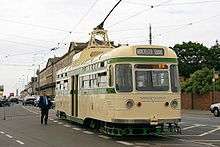
The Coronation cars, named because they were introduced in Queen Elizabeth II's Coronation Year, 1953, were 25 trams built between 1952 and 1953 by Charles Roberts Ltd at Horbury Junction works, near Wakefield. They were numbered 304-328, until 1968 when twenty four of them were renumbered 641-664, with 313 having been withdrawn and scrapped without being renumbered. The sophisticated VAMBAC control system proved to be their Achilles' heel as it was unreliable. Thirteen trams had their VAMBAC systems replaced by conventional controllers from withdrawn tramcars during the 1960s, prolonging their comparatively short service life to 1975, when they were withdrawn. The unmodified examples were withdrawn from service in 1968. Twenty two of them were scrapped, leaving only three examples left. One was retained for heritage purposes (660). Two were preserved by the Lancastrian Transport Trust (LTT) until 2013, when 304 (later 641) and 663 joined the heritage fleet alongside 660.
Coronation 304, the first of the fleet, was bought for preservation and achieved celebrity status in 2002 when it was the subject of the seventh episode of the second series of the Channel 4 television programme Salvage Squad. It was returned to working order by Salvage Squad and LTT members and unveiled to the public on 6 January 2003 when it was filmed carrying out test runs along Blackpool Promenade.[52][53][54]
Progress Twin Set cars
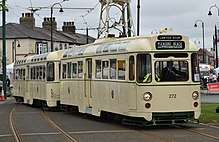
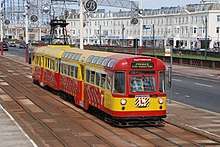
The Progress Twin Set cars were 20 single deck towing and trailer cars made up from 10 towing cars numbered 272-281 and 10 trailer cars numbered T1-T10. English Electric Railcoach cars Nos. 275 and 276 were rebuilt in 1958 with flat ends and tested as the prototype Twin Set, with No. 276 towing No. 275 which had temporarily become a trailer. The ends of these cars were heavily redesigned to resemble the then contemporary Coronation cars. Deemed a success, English Electric Railcoach cars Nos. 272-274 and 277-281 were rebuilt as towing cars between 1958 and 1962, while 275 had its electrical equipment reinstalled. The 10 trailers were built brand new by Metro Cammell in 1960, looking almost identical to the towing cars except for the lack of a pantograph tower. Initially, any towing car could tow any trailer, such as 272 and T9, until standardisation took place where each towing car towed the trailer with the corresponding last digit number, such as No. 273 and No. T3. The Twin Set cars were originally driven only from the towing end, until seven sets (281+T1 and 272+T2 to 277+T7) were later converted to be driven from either end with cabs in the trailers. In the 1968 tramway fleet renumbering programme, towing car No. 281 was renumbered 671, towing cars Nos. 272-280 became 672-680 and trailer cars Nos. T1-T10 became 681-690. Towing cars Nos. 678-680 operated singly after trailer cars 688-690 were withdrawn in 1972 and scrapped.[20] In 2004, 676+686 and 677+687 were withdrawn, with No. 677 being scrapped in 2007 to provide parts for the Illuminated Western Train restoration.
With the Flexity 2 tramcars operating the main day to day services from 2012, the Twin Set cars were withdrawn at the end of 2011. 671+681 were sold, but No. 671 joined the heritage fleet in 2015 and No. 681 joined in 2016 and they are currently stored. In 2012, 672+682 were reactivated and renumbered back to their original pre-1968 numbers 272 and T2 and were repainted into original 1960s cream livery. On 24 September 2016, No. 272 suffered fire damage whilst in service near Gynn Square due to an electrical fault and this set is currently stored out of service awaiting repair. 673+683 were preserved by the Fleetwood Heritage Leisure Trust. 674+684 were preserved by the North Eastern Electrical Traction Trust. In September 2015, 675+685 were reactivated and repainted into 1970s green and cream with an orange pantograph tower for 675.[55] 676+686 joined the heritage fleet and are currently stored. No. 687 was preserved by the Fleetwood Heritage Leisure Trust.
OMO cars
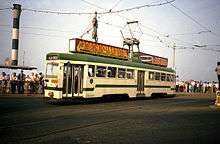
The One-Man Operated (OMO) cars were 13 trams numbered 1-13. Between 1972 and 1976, the 11 remaining English Electric Railcoaches in their original form, Nos. 608-610, 612-617 and 619-620, as well as No. 611 with flat cab-ends and No. 618 with tapered cab-ends, were rebuilt with extended platforms tapered at each end so passengers could enter at the front and pay the driver, whilst the original central doors became used by passengers only to exit the tramcars. This meant the trams could run with a crew of only one, reducing costs and possibly saving the tramway from closure. No. 616 was the first to be rebuilt as an OMO car in 1972, becoming No. 1. It was followed in the same year by No. 620 as No. 2, No. 610 as No. 3, No. 608 as No. 4 and No. 609 as No. 5. In 1973, No. 617 became No. 6 and No. 619 became No. 7. In 1974, No. 612 became No. 8, No. 613 became No. 9 and No. 614 became No. 10. In 1975, No. 615 became No. 11 and No. 611 with the flat cab-ends became No. 12. In 1976, No. 618 already with the tapered cab-ends but without the doors at the ends prior to rebuilding as an OMO car, became No. 13.
They ran the main year-round service until they were replaced by the Centenary class trams in the 1980s. No. 13 was the first to be withdrawn in 1984, whilst the last OMO cars in service, Nos. 5, 10 and 11, were withdrawn in 1993. After withdrawal, No. 10 was sold and became a coffee shop at a conference centre in Reading in 1996, but was scrapped in 2005. No. 11 was used as a test car to trial experimental equipment and was scrapped in 2000. Three of the OMO cars were preserved: No. 5 is stored at the National Tramway Museum's off-site facility awaiting restoration, No. 8 last carried passengers in 2010 but is currently stored in Blackpool awaiting further overhaul work and No. 7 was rebuilt as a replica Vanguard tram in 1987, renumbered back to 619 and is at the Heaton Park Tramway in Manchester.
Jubilee cars
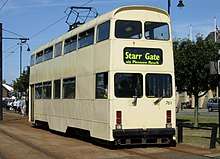
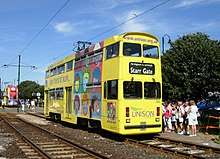
The Jubilee cars were 2 trams numbered 761 and 762. In the late 1970s, Blackpool Transport, having completed its OMO rebuild programme, was still left with a significant surplus of cash. Using a redundant Balloon (725), BTS set to work on creating an experimental double-deck OMO car. It was completed in 1979; unlike the OMOs it did not have centre doors and had a much more bus-like appearance. It was thought a success, so a second was created using another redundant Balloon (714), which unlike the first, retained its centre doors. They were numbered 761 and 762 respectively. Although a success and big crowd-movers, no more were built either brand new or rebuilt from the Balloons. The pair carried on in service until the modernisation of the tramway in 2011–2012. Both cars are preserved; 761 by the Blackpool Heritage Trust and 762 by the National Tramway Museum in Crich. After a long period of refurbishment, 762 carried out test runs at the museum and re-entered service in September 2014. 761, meanwhile, was preserved by the Fleetwood Heritage Leisure Trust and was in outside storage until December 2013 when it was moved back in to Blackpool Transport's Rigby Road Depot. In May 2017, 761 was transferred from the Fleetwood Heritage Leisure Trust to Blackpool Heritage Trust.[56][57] Both cars carried many colourful advertising liveries throughout their lives and both still carry one in preservation; 762 carries a bright scheme advertising an attraction at Blackpool's Pleasure Beach theme park.
Centenary cars
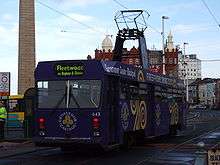
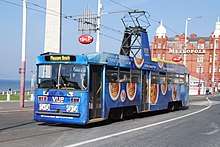
The Centenary cars were 8 single deck, one-man operated trams numbered 641-648 (648 originally being numbered 651),[20] with flat ends and a revised door layout, giving them a more bus-like appearance compared to previous tramcar designs. They have a capacity of 52 passengers (of which 16 are standing). The position of the doors means that they can be operated by just a driver, as opposed to having a crew of two or three on board. This was useful during low season and early morning/late night services when there was little demand, as it allowed the network to keep labour costs down.
They were built by East Lancashire Coachbuilders from 1984 to 1988.[20] The first two vehicles (641 and GEC Traction test bed 651, later rebuilt into conventional Centenary 648) were completed ahead of the tramway's centenary year, hence their name. Originally intended to replace the OMO cars which were suffering from metal fatigue, ten were ordered. However, due to cost cutting only seven were built for Blackpool Transport, with GEC's 648 later joining the fleet.[58] The cost cutting continued, as although the bodies, chassis and bogies were new, the motors and wheelsets were pre-war, refurbished ones from withdrawn cars. The bogie design continued the theme of the "O.M.O." and London Transport Underground cars, having "Metalastik" rubber/metal bonded springs. No. 641 was built with a unique roof advert box. Between 1998-2006, a mid-life overhaul programme was carried out on all the Centenary cars, altering their appearances with alternate designs. No. 648 however was overhauled with its original shape left intact. A feature of the Centenary trams after rebuilding from the overhaul programme was the roof sides which were rebuilt to appear flush with the body sides, which provided more space for advertising.
With the introduction of the new Bombardier Flexity 2 trams in 2012, all eight Centenary cars were withdrawn. Six of them were sold with two used on heritage tours: Nos. 642 and 648, the latter of which has been restored back to its original appearance. This is not strictly accurate, as 648 was numbered 651 when originally delivered. Also the work was done on a tight budget meaning some of the modern features had to be retained. The retained Centenaries unfortunately suffer from electrical issues, with 642 failing on the first day of its re-entry into service, although it has operated successfully since. Two of the sold cars are preserved: Centenary 641 is owned by the Fleetwood Heritage Leisure Trust; Centenary 647, the last traditional standard gauge tram built in Great Britain, is owned by the North Eastern Electrical Traction Trust, based at the North East Land, Sea and Air Museum. Its all over advert has been stripped away and it is intended that it will be repainted into a fictional 1920s style red, teak and white livery. Two of the sold cars are based at outside locations: 643 is used as a classroom at Brooke School in Rugby, 644 is stored at Farmer Parrs Animal World in Fleetwood. 645 was stored at Windy Harbour Holiday Park in Singleton near Blackpool, but moved back to Rigby Road depot to join the heritage fleet on the 27 July 2017. After initially being preserved by the Fleetwood Heritage Leisure Trust, 646 was scrapped in October 2012 after it was vandalised.
Illuminated cars
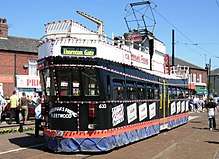

A variety of tramcars of different designs were rebuilt as illuminated theme cars. They mainly run along the illuminated part of the promenade, from Starr Gate to Bispham, during the Illuminations. There was originally no numbering series until 1968 when the remaining trams in the fleet were numbered 731-736.[20] The illuminated trams have carried a variety of adverts since the 1960s.
The Venetian Gondola, the first illuminated theme car, was rebuilt from Marton Box car No. 28 in 1925 and was scrapped in 1963. The Lifeboat, rebuilt from Marton Box car No. 40 in 1926, was scrapped in 1962. The Cottage tram, rebuilt from Marton Box car No. 33 in 1933, was scrapped in April 1935. The Bandwagon/ Progress tram, rebuilt from Blackpool and Fleetwood Crossbench Rack tram No. 141 (originally No. 27) in 1937, was given a further rebuild in 1949 and was scrapped in November 1959.
The Blackpool Belle (731), rebuilt from Toastrack car No. 163 in 1959, was preserved in the United States in 1982 by the Oregon Electric Railway Museum after being withdrawn in Blackpool in 1978. However, it was sold again to a research facility in Texas, United States, who used it to test alternative power sources and after completing this role, the body was scrapped, with only the underframe left intact.
The Rocket (732) was rebuilt from Pantograph car No. 168 in 1961. The Western Train Locomotive (733) was rebuilt from English Electric Railcoach car No. 209 in 1962 and the Western Train Carriage (734) was rebuilt from Pantograph car No. 174 in 1962. The Locomotive and Carriage were paired together to form the Western Train (733+734). The Hovertram (735) was rebuilt from English Electric Railcoach car No. 222 in 1963. The Frigate (736) was rebuilt from Pantograph car No. 170 in 1965 and was further rebuilt with an altered shape at the back and on top of the roof in 2004. The Trawler (633) was rebuilt from Brush Railcoach car No. 633 in 2001 and was renumbered 737 in 2008.
A campaign by the local newspaper, the Blackpool Gazette in 2006 to get one of the illuminated trams, The Western Train, back on track,[59] resulted in a £278,000 Heritage Lottery Fund grant to restore the two tramcars in the Western Train set which first ran in 1962. They had been withdrawn in 1999 and stood derelict at Rigby Road depot.[60] The tramcars returned to service during the 2009 Illuminations Switch-On.[61] In January 2008 it was revealed that another iconic illuminated tram, the Rocket, which had been in service between 1961 and 1999 but which had since then stood idle, was also due to be restored for the Illuminations in 2012 at a cost of about £150,000 and with the help of a newly created Friends of the Illuminations group.[62] The full restoration did not occur but it was cosmetically restored in 2012 and used as a static display as part of the Illuminations for 2012 and 2013.
With the introduction of the Flexity 2 trams in 2012, the Western Train (733+734), the Frigate (736) and the Trawler (737) were retained as part of the heritage fleet. In 2014, the Rocket (732) joined the heritage fleet from the Lancastrian Transport Trust. In September 2016, the Hovertram (735) returned to Blackpool initially on loan, but its owners, the North Eastern Electrical Traction Trust, offered Blackpool Heritage Trust the opportunity to purchase it. The Hovertram was purchased in 2017 and joined the heritage collection in Blackpool.
Current fleet
The fleet of heritage trams are used most weekends throughout the year. The list of the fleet as of 2 August 2018 is as follows:
| Class | Image | Number | Built | Livery | Status |
|---|---|---|---|---|---|
| OMO |  |
8 | 1974 | Plum and Custard | Awaiting overhaul |
| Birkenhead Corporation Tramways open-topper | 20 | 1900 | Maroon and Cream | Undergoing repairs. On loan from the Wirral Tramway | |
| Blackpool and Fleetwood Tramroad Box car | .jpg) |
40 | 1914 | Varnished Woodwork and Cream | Operational. On long term loan from the National Tramway Museum |
| Lytham St. Annes Corporation Tramways open balcony double-decker | 43 | 1924 | Blue and White | Awaiting restoration | |
| Bolton Corporation Tramways double-decker | 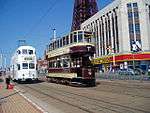 |
66 | 1901 | Maroon and Cream | Operational |
| Standard | 143 | 1924 | Red, White and Teak | Undergoing restoration | |
| Standard | 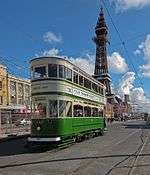 |
147 | 1924 | Green and Cream | Operational |
| Boat |  |
227 | 1934 | Red and White | Undergoing overhaul |
| Boat | 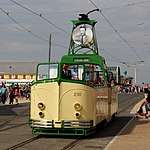 |
230 | 1934 | Green and Cream | Awaiting overhaul |
| Brush Railcoach | 259 | 1937 | Works Green | Awaiting restoration | |
| Twin Set |  |
272+T2 | 1960 | Cream | Awaiting overhaul |
| English Electric Railcoach | 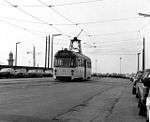 |
279 | 1935 | N/A | Undergoing overhaul |
| Brush Railcoach | 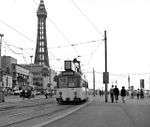 |
290 | 1937 | Green and Cream | Awaiting restoration |
| Coronation |  |
304 | 1952 | Green and Cream | Awaiting overhaul |
| Boat | 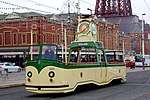 |
600 | 1934 | Green and Cream | Operational |
| Brush Railcoach | 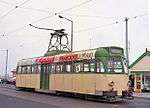 |
621 | 1937 | Green and Cream | Operational |
| Brush Railcoach | 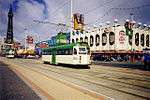 |
631 | 1937 | Green and Cream | Operational |
| Brush Railcoach |  |
632 | 1937 | Green and Cream | Awaiting overhaul |
| Brush Railcoach | 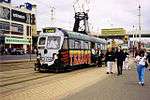 |
634 | 1937 | Green and Cream | Awaiting overhaul |
| Centenary | 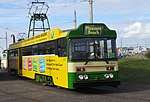 |
642 | 1986 | Yellow, Green and Cream with Heritage Tram adverts | Operational |
| Centenary | 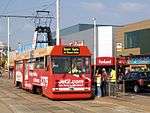 |
645 | 1987 | Red and White | Awaiting restoration |
| Centenary |  |
648 | 1985 | Green and Cream | Operational |
| Coronation | .jpg) |
660 | 1953 | Green and Cream | Awaiting overhaul |
| Coronation | 663 | 1953 | Green and Cream | Undergoing restoration | |
| Twin Set | 671+681 | 1960 | Green and Yellow | Awaiting restoration | |
| Twin Set | 675+685 | 1958 | Green and Cream | Undergoing overhaul | |
| Twin Set | 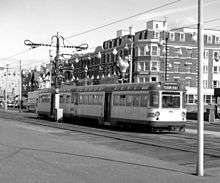 |
676+686 | 1958 | Green and Cream | Awaiting restoration |
| Ex Towing English Electric Railcoach |  |
680 | 1960 | Green and Cream | Operational. On loan from Heaton Park Tramway |
| Balloon | .jpg) |
701 | 1934 | Red and White | Operational |
| Balloon | 703 | 1934 | Red and Cream | Awaiting overhaul | |
| Balloon | 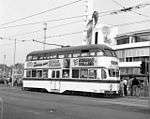 |
704 | 1934 | Advert for Eclipse at the Globe, Pleasure Beach | Awaiting restoration |
| Balloon open-topper | _Open-topped_Balloon_car.jpg) |
706 | 1934 | Green and Cream | Awaiting overhaul |
| Balloon | 708 | 1934 | Green and Cream | Awaiting restoration | |
| Balloon | 715 | 1934 | Green and Cream | Operational | |
| Balloon | _(9127559828).jpg) |
717 | 1934 | Green and Cream | Operational |
| Balloon |  |
723 | 1935 | Green and Cream | Operational |
| Illuminated Rocket | 732 | 1961 | White and Green | Awaiting restoration | |
| Illuminated Western Train | 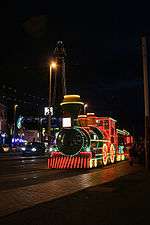 |
733+734 | 1962 | Red, Green and Yellow | Operational |
| Illuminated Hovertram | 735 | 1963 | White and Black | Awaiting restoration | |
| Illuminated Frigate | 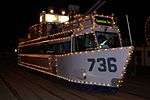 |
736 | 1965 | White | Operational |
| Illuminated Trawler |  |
737 | 2001 | Blue, Red, Black and White | Operational |
| Jubilee |  |
761 | 1979 | Advert for Wynsors World of Shoes | Awaiting restoration |
| Tatra T3 | 902 | 1969 | Red and Cream | On display. On loan from the National Tramway Museum | |
| Glasgow Corporation Tramways open-topper | 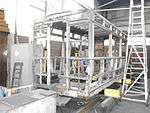 |
1016 | 1904 | N/A | Awaiting restoration |
Works cars
Alongside the tramcar fleet designed to carry passengers in service, there have been various trams in use on the Blackpool Tramway carrying out various roles as works cars, including inspection and repairing of the overhead wires and towing failed trams back to the depots. There have also been various wagons and battery powered vehicles used on the tramway, including: Blackpool and Fleetwood Tramroad Tower Wagon No. 749 from 1907, preserved by Beamish Museum, Reel Wagon No. 750 from 1907 and the Crab from 2012, which is a battery powered vehicle used to shunt the Flexity 2 trams at Starr Gate Depot (its full identity being Crab 1500 E).
Several passenger trams of various classes which had been withdrawn from service were reused as works cars. This includes: No. 2 (formerly Marton Box No. 33 from 1920-1928), No. 3 (formerly Fleetwood Crossbench No. 126, earlier No. 1 from 1939-1951), Conduit car No. 4 from 1912-1934, Conduit cars 5 and 6, No. 5 (formerly Fleetwood Box No. 114, earlier No. 40 from 1936-1960), No. 5 (formerly English Electric Railcoach No. 609, earlier No. 221 from 1965-1971 - rebuilt as OMO No. 5 in 1972), No. 6 (formerly Fleetwood Crossbench No. 132, earlier No. 7 from 1939-1955), No. 7 (formerly Toastrack No. 161 from 1942-1958), No. 15 (formerly Toastrack No. 165 from 1951-1968), Fleetwood Box car No. 112 (originally No. 38) from 1936, Fleetwood Crossbench cars 127 (originally No. 2) and 128 (originally No. 3) from 1938, Fleetwood Crossbench car No. 129 (originally No. 4) from 1938-1939, Fleetwood Crossbench car No. 133 (originally No. 8) from 1938-1942, Fleetwood Crossbench car No. 135 (originally No. 10) from 1937-1939, Fleetwood Crossbench car No. 137 (originally No. 12) from 1937-1942, Fleetwood Crossbench car No. 139 (originally No. 25) from 1924, Pantograph car No. 167 from 1954-1962, Pantograph car No. 170 from 1962-1965 - rebuilt as Illuminated Frigate No. 736 in 1965, Brush Railcoach No. 259 (originally No. 287, then No. 624, then No. 748) from 1971-2002, Rail Crane No. 260 (originally Brush Railcoach No. 291, then No. 628, then Rail Crane No. 751) from 1973, No. 753 (formerly No. 3, earlier Standard No. 143) from 1957-1990, No. 754 (formerly No. 4, earlier Marton Box No. 31) from 1934-1984 and No. 757 (formerly No. 17, earlier Toastrack No. 166 from 1953-1971). Fleetwood Crossbench car No. 2, Conduit car No. 4, OMO car No. 5, Marton Box car No. 31, Fleetwood Box car No. 40, Standard car No. 143, Toastrack car No. 166, Pantograph car No. 167, Brush Railcoach car No. 259 and the Illuminated Frigate No. 736 were preserved. The Rail Crane No. 260 has been withdrawn and is stored at Rigby Road Depot. All of the other passenger trams which were reused as works cars were scrapped.
The electric works locomotive was built in 1927 by English Electric to a steeplecab design, for use in hauling coal wagons from a railway siding behind Copse Road Depot in Fleetwood to Thornton Gate sidings. The locomotive did not receive a fleet number in the Blackpool tramcar fleet, but it is known by its works number as 717. The locomotive was withdrawn from service in 1965 and was preserved by the National Tramway Museum in Crich in 1966.
In 1928, the Railgrinder No. 1 was built for use in carrying various items around the various depots, as well as for rail grinding and clearing snow with a snowplough. A second railgrinder tram, No. 2 was built in 1935 for the same roles. However, No. 2 was withdrawn in 1965 due to the Blackpool Tramway contracting in the 1960s and it was preserved by the National Tramway Museum in Crich. In 1968, No. 1 was renumbered No. 2 and in 1972 it was renumbered 752. By 2002, No. 752 had been withdrawn and was preserved by the Heaton Park Tramway in 2008, returning to its original number in 2014.
In 1982, Blackpool Corporation Transport acquired a Unimog road-rail vehicle built by Mercedes-Benz, numbered 440. A second road-rail vehicle was acquired in 1988 by Blackpool Transport, who had succeeded Blackpool Corporation Transport in 1986. The second road-rail vehicle was built by Bedford/ Bruff and numbered 441. In 1996, No. 440 became No. 940 and No. 441 became No. 941. In 2002, a third road-rail vehicle built by Mercedes-Benz was acquired and numbered 939. In 2006, a fourth road-rail vehicle built by Brecknell Willis was acquired and numbered 938. No. 940 was scrapped in 2005 whilst No. 941 was scrapped in 2007.
In 1992, Engineering tram 754 was built by East Lancashire Coachbuilders for a variety of uses on the tramway. As well as having two trolley poles, one fitted at each end, it was fitted with a diesel generator which allows it to operate on the tramway whenever the electricity supply is turned off. It also has an inspection tower for inspecting the overhead wires.
Other cars
In addition to the various Blackpool Tramway fleet of trams that have operated in Blackpool, there have been various trams representing other tramways either added to the fleet, put on loan or stored for other organisations over many years. The first tram to have operated on another system to visit Blackpool was Southampton 45 in 1949, which was stored inside Marton Depot for its owners, the Light Rail Transport League whilst the group attempted to find a permanent home in preservation for it. Ownership of Southampton 45 transferred to the National Tramway Museum in Crich during its stay in Blackpool and the tram left in 1958 for its new home in Crich.
In preparation for the 100th anniversary of the Blackpool Tramway in 1985, several trams were loaned to Blackpool, including: Bolton 66 (1981 onwards), Edinburgh 35 (1983-1988), Sheffield 513 (1984-1985, 2001-2011), Glasgow 1297 (1984-1986), Hill of Howth 10 (1985-1989), New South Wales, Australia steam tram 47 John Bull (1985) and Manchester 765 (1985-1988, 2010-2011). Some of these trams would return to Blackpool for further loan periods. Bolton 66, owned by the Bolton 66 Tramcar Trust, became the first tram outside of the Blackpool tram fleet to operate in passenger service in Blackpool and it joined the heritage fleet in 2012. New South Wales 47 became the first steam tram to operate in Blackpool.
During the 1990s, Blackpool Transport hired a Speno Railgrinder, numbered HRR 12-M1 for use in grinding the rails and it was towed by an Iveco Lorry.
Prior to a new Birkenhead Tramway being opened in 1995 as a heritage tramway, two trams were built in Hong Kong in 1992 for use on that tramway as the first trams to provide a service. The two trams became Birkenhead 69 and 70, following on from the first sixty-eight Birkenhead electric trams. Due to the Birkenhead Tramway not opening until 1995, they were loaned to Blackpool for testing and operated in passenger service, with Birkenhead 70 becoming the first foreign built tram to operate in Blackpool in 1993. Birkenhead 70 left Blackpool in 1994 to operate on the Birkenhead Tramway, followed by Birkenhead 69 in 1995.
Stockport 5 was loaned to Blackpool for passenger service between 1996-2011. Glasgow 1245 arrived in Blackpool in 1998 from the East Anglia Transport Museum, with intentions for it to be restored and join the Blackpool Tramway fleet. However, these intentions did not happen and Glasgow 1245 left Blackpool in 2002 to join the Summerlee Museum collection of trams.
In 1997, a tram built by Tram Power arrived in Blackpool for testing purposes and it became the first articulated tram in Blackpool. This articulated tram was originally known as the Roadliner, but was rebranded as the City Class tram. The City Class tram was given the number 611 in the Blackpool tramcar fleet, which had last been used by English Electric Railcoach No. 611 prior to being rebuilt as OMO car No. 12. City Class tram 611 departed Blackpool in 2000 after testing, so that modifications could be made prior to a second visit for further testing and it returned in 2005. In January 2007, No. 611 caught fire whilst being tested, causing extensive damage. No. 611 left Blackpool in the same year and has since been rebuilt. No. 611 returned to Blackpool in 2018, now in a silver livery, for storage purposes only, with plans for it to eventually operate on a test tramway in Preston.
In 2010, Oporto, Portugal 273 and Liverpool 762 were loaned to Blackpool for the 125th anniversary of the Blackpool Tramway, with both trams leaving Blackpool in the same year after the celebrations. In 2011, Cardiff water car 131 arrived in Blackpool for use in scrubbing and preparing the newly laid track on New South Promenade for the start of testing of the Flexity 2 trams. Cardiff 131 left Blackpool in 2012.
In 2016, the partially restored Lytham St. Annes 43 arrived in Blackpool for a long term loan from its owner, where it will eventually be fully restored for use in passenger service. The remnants of Glasgow 1016 also arrived in Blackpool in 2016, having been acquired by the Blackpool Heritage Trust and it will be restored to original open top double deck condition as Paisley 16 or Glasgow 1016. In 2017, Birkenhead 20 was loaned to Blackpool for twelve months, but has so far not operated there in passenger service due to some teething problems.
In 2018, Blackpool Transport hired a Meili VM8000 Railgrinder, numbered 9602 for use in grinding the rails. Also in 2018, Halle 902 was loaned to Blackpool for storage purposes only in order to free up additional space at the National Tramway Museum.
Tickets
Tickets are purchased from the conductor on board each tram. Single fares range from £2.00 to £2.50 for adults, with daily, weekly and monthly passes also available which can be used on trams (excluding heritage trams) and Blackpool Transport buses. Heritage tram tickets are £3.50 adult and £2.00 child for a round trip tour between Pleasure Beach and Cabin. Day tickets are available at £11.00 adult and £6.00 child. Family day tickets are also available at £25.00 (1 adult and 4 children or 2 adults and 3 children). In addition to heritage tours, heritage day tickets can also be used on all Blackpool Transport trams and buses as well as autumn illumination tours.
National Rail tickets to Blackpool North or Blackpool South with a Plusbus add-on are also valid on Blackpool trams between Cleveleys (Thornton Gate) and Starr Gate.
Incidents and accidents
There have been several accidents where pedestrians have been hit. Most recently a pedestrian, Maureen Foxwell age 70, was killed by a speeding driver at a designated crossing on 5 August 2009. The driver, who was travelling at over three times the speed limit near tram stops of 4 mph, was sentenced to 15 months in prison.[63] Only two very serious collisions between vehicles have occurred since operation began in 1885. These are:
- 22 July 1980 – Balloon trams 705 and 706 collided head-on on the turning loop at the Pleasure Beach. 705 was bound for Starr Gate whilst 706 was stationary on the loop. 705 was on the wrong line due to the points being incorrectly set and ran into 706, about to depart for Fleetwood. Both trams were severely damaged; 705 was scrapped, the only Balloon to meet this fate until 2009 when 722 was scrapped due to collision damage. 706 was rebuilt as an open-topped Balloon. A County Court judgement in 1982 found that Blackpool Corporation were 80% to blame for the collision.[64][65]
- 13 March 2004 – Centenary tram 644 derailed and collided with a wall on the promenade near Gynn Square. One of the poles from the Illuminations had been deliberately placed in the groove of the left-hand rail of the northbound line. 644 narrowly missed a pedestrian walking along the promenade and went through the wall, knocking debris onto the walkway below. The tram was balancing on the wall, but did not fall off.
- 24 January 2007 – Citytram prototype 611, while undergoing a trial run, caught fire near Foxhall, causing severe damage to one end of the cab. No-one was injured, but it did not return to Blackpool when repaired.
- 4 April 2012 – On the very first day of Flexity 2 operation, 006 working the very first journey with passengers derailed at Fleetwood Ferry due to a buildup of sand in the groove of both tracks.
System maps
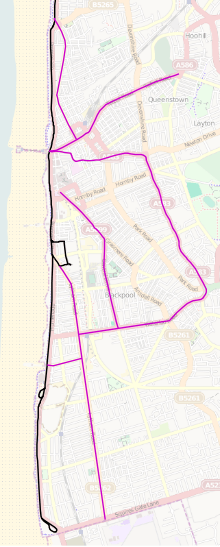
Legend: routes dismantled in 1960s, existing routes

See also
References
- ↑ "Blackpool Tramway – Destinations". Blackpool Tramway. Archived from the original on 29 September 2013. Retrieved 9 March 2013.
- 1 2 "Light Rail and Tram Statistics: England 2017/18" (PDF). Department for Transport. Retrieved 28 June 2018.
- ↑ "Blackpool's New Tramway". www.blackpool.gov.uk. Retrieved 2018-03-11.
- ↑ "Tram Fleetwood to Starr Gate". www.blackpooltransport.com. Retrieved 2018-03-11.
- ↑ "Timetables & Fares". www.blackpoolheritage.com. Retrieved 2018-03-11.
- ↑ "Blackpool trams". thetrams.co.uk. Archived from the original on 7 July 2011. Retrieved 3 November 2007.
- 1 2 3 4 5 6 "Blackpool Trams". Fylde Tramway Society. 3 September 2004. Archived from the original on 17 July 2011. Retrieved 19 November 2010.
- 1 2 Rosthorn, Andrew (19 September 2013). "Trams for Blackpool North". Lancashire & North West Magazine. Lancashire & North West. Archived from the original on 15 March 2015.
- ↑ "BBC News - What happened to the 10-year transport plan?". news.bbc.co.uk. Archived from the original on 3 September 2017. Retrieved 3 September 2017.
- ↑ "Anger over tram network". Fleetwood Weekly News. 26 March 2004. Archived from the original on 1 April 2008. Retrieved 3 November 2007.
- 1 2 Parkinson, Shelagh; Harris, Emma (30 May 2007). "Track blamed for tram drama". Blackpool Gazette. Archived from the original on 20 April 2013. Retrieved 2007-11-03.
- ↑ "New tram catches fire during test". BBC News. 24 January 2007. Retrieved 1 October 2010.
- ↑ Butler, Heather; Harris, Emma (25 January 2007). "Not so supertram". Blackpool Gazette. Archived from the original on 19 April 2013. Retrieved 2007-11-03.
- ↑ Parkinson, Shelagh (1 February 2008). "Blackpool gets £85m for trams". Blackpool Gazette. Archived from the original on 2 February 2008. Retrieved 1 February 2008.
- 1 2 "Rejuvenated Blackpool tramway reopens". Railway Gazette International. 3 April 2012. Archived from the original on 7 April 2012. Retrieved 15 June 2015.
- 1 2 "Visitor Information". Fleetwood Transport Festival. Archived from the original on 9 August 2007. Retrieved 2007-11-03.
- ↑ "Blackpool Transport Heritage Trams". Archived from the original on 29 March 2017.
- ↑ "Blackpool Transport". Archived from the original on 9 June 2012. Retrieved 24 May 2012.
- ↑ "Blackpool tram route: Starr Gate–Fleetwood". thetrams.co.uk. Archived from the original on 14 November 2007. Retrieved 3 November 2007.
- 1 2 3 4 5 6 7 "The trams". thetrams.co.uk. Archived from the original on 14 November 2007. Retrieved 3 November 2007.
- 1 2 3 Lark, Claire (12 July 2007). "Tram Sunday Volunteers' Plea". Fleetwood Weekly News. Archived from the original on 9 July 2009. Retrieved 3 November 2007.
- ↑ "Tram Sunday celebrates 21st Anniversary". Fleetwood Weekly News. 10 March 2005. Archived from the original on 9 July 2009. Retrieved 3 November 2007.
- ↑ Evans, Karen (12 July 2007). "Full steam ahead for Tram Sunday". Blackpool Gazette. Archived from the original on 9 July 2009. Retrieved 3 November 2007.
- ↑ "Fleetwood Transport Festival saved". Blackpool Gazette. 5 April 2007. Archived from the original on 9 July 2009. Retrieved 3 November 2007.
- ↑ "Making Blackpool better". www.blackpool.gov.uk.
- ↑ "Blackpool's new tramway". www.blackpool.gov.uk.
- ↑ "Tramway terminal centre of Talbot Gateway phase two". www.blackpool.gov.uk.
- ↑ Marsden, Paul (17 September 2007). "Looking back with TV soap favourites". Blackpool Gazette. Archived from the original on 19 April 2013. Retrieved 2007-11-03.
- ↑ "Copse Road depot consigned to history - British Trams Online News". www.britishtramsonline.co.uk. Archived from the original on 23 January 2018.
- ↑ http://www.blackpooltrams.info/news_main.php?w=1&p=1240437107&s=1 Archived 10 March 2012 at the Wayback Machine.
- ↑ "Three Blackpool fleets defined". Today's Railways. Platform 5 Publishing (127): 24. 2012.
- ↑ Modern Railways Issue 731, August 2009. "Tram order for Blackpool", page 10.
- ↑ "Blackpool supertram is here!". Blackpool Gazette. 8 September 2011. Archived from the original on 10 June 2015. Retrieved 15 June 2015.
- ↑ "Tram bogie turntable". Railway Gazette. Retrieved 2010-07-25.
- ↑ "Flexity 017 makes its journey to Blackpool!". British Trams Online. British Trams Online. Archived from the original on 19 January 2018.
- ↑ "Flexity 018 completes Blackpool's latest tram order". British Trams Online. British Trams Online. Archived from the original on 19 January 2018.
- ↑ "In Pictures: Blackpool's newest trams enter service". British Trams Online. British Trams Online. Archived from the original on 7 March 2018.
- ↑ "Blackpool tram 144". Seashore Trolley Museum. Archived from the original on 20 December 2015. Retrieved 14 June 2015.
- ↑ Price, J. H. (August 1978). "Museum News", five-page article about OERHS and its museum in Glenwood. Modern Tramway, pp. 270–273, 276. Ian Allan Publishing.
- ↑ "Museums [news section]". Tramways & Urban Transit. Ian Allan Publishing/Light Rail Transit Association. July 2006. p. 277.
- ↑ "Oregon Electric Railway Museum". www.facebook.com. Archived from the original on 10 May 2018. Retrieved 25 July 2017.
- ↑ UK Retail Price Index inflation figures are based on data from Clark, Gregory (2017). "The Annual RPI and Average Earnings for Britain, 1209 to Present (New Series)". MeasuringWorth. Retrieved 6 November 2017.
- 1 2 3 "Passenger Cars – Part II". tramway.com. Archived from the original on 21 November 2008. Retrieved 4 November 2008.
- 1 2 "Blackpool and Fleetwood Tramway Fleet List" (Microsoft Word Document). British Trams Online. 12 October 2008. Archived from the original on 29 February 2008. Retrieved 4 February 2008.
- ↑ "The Blackpool Tramway: Trams". thetrams.co.uk. Archived from the original on 27 December 2008. Retrieved 4 November 2008.
- 1 2 "Blackpool Boat Cars". The Blackpool Tramway website. Archived from the original on 25 October 2009. Retrieved 4 November 2008.
- ↑ "Blackpool Boat: 'The People's Choice'". Market Street Railway. Archived from the original on 16 May 2008. Retrieved 4 November 2008.
- ↑ "Fleet Liveries". tramway.com. Archived from the original on 24 July 2008. Retrieved 4 November 2008.
- ↑ "Our Collection – City Cars – #Car 606 ("Boat Car")". Lake Shore Electric Railway. Archived from the original on 19 November 2008. Retrieved 2015-06-15.
- ↑ "Blackpool Transport Services 606". Colesville, Maryland, US: National Capital Trolley Museum. Archived from the original on 10 August 2015. Retrieved 14 June 2015.
- ↑ "New Boat Could Be on Display This Weekend - Market Street Railway". streetcar.org. 30 October 2013. Archived from the original on 23 January 2018.
- ↑ Higgs, Philip (12 May 2004). "Coronation tram – back on the Blackpool throne". Old Glory Magazine. Archived from the original on 14 October 2006. Retrieved 2007-03-12.
- ↑ "Hall of Fame: Blackpool Coronation 304". British Trams online. 3 November 2003. Archived from the original on 28 September 2007. Retrieved 12 March 2007.
- ↑ "Salvage Squad – tram". Channel 4. Archived from the original on 11 October 2008. Retrieved 4 November 2008.
- ↑ "In Pictures: 675+685 return to service for 'Blackpool 130′ event - British Trams Online News". www.britishtramsonline.co.uk. Archived from the original on 18 August 2016.
- ↑ "The site for Blackpool trams, transport & more". The site for Blackpool trams, transport & more. Archived from the original on 14 October 2017.
- ↑ "Jubilee car 761 acquired by Blackpool Heritage Trust - British Trams Online News". www.britishtramsonline.co.uk. Archived from the original on 14 October 2017.
- ↑ "Blackpool Centenary Cars". The Blackpool Tramway Website. Archived from the original on 2009-10-24. Retrieved 2009-02-11.
- ↑ "Help save resort 'Western Train'". Blackpool Gazette. 5 May 2005. Archived from the original on 14 January 2013. Retrieved 2007-11-03.
- ↑ "Readers win battle to save Lights tram". Blackpool Gazette. 4 October 2006. Archived from the original on 29 February 2008. Retrieved 3 November 2007.
- ↑ "Public delight at tram cash pledge". Blackpool Gazette. 10 October 2006. Archived from the original on 29 February 2008. Retrieved 3 November 2007.
- ↑ Ettridge, Lisa (14 January 2008). "Iconic Blackpool tram to make Prom return". Blackpool Gazette. Archived from the original on 16 January 2008. Retrieved 16 January 2008.
- ↑ "Blackpool speeding death tram driver jailed". BBC News. 8 December 2010. Archived from the original on 11 December 2010.
- ↑ "Apology for man blamed for Blackpool tram crash". BBC News. Archived from the original on 14 March 2017.
- ↑ "In pictures: Son of Blackpool tram driver wants apology". BBC News. Archived from the original on 20 April 2017.
Further reading
- Abel, P.H.; McLoughlin (October 1997). Blackpool Trams: The First Half Century 1885–1932. I. The Oakwood Press. ISBN 0-85361-503-9.
- Higgs, Philip (April 1984). Blackpool's Trams: As Popular as the Tower. Lancastrian Transport Publications. ISBN 0-9509405-0-X.
- Johnson, Peter (July 1986). Trams in Blackpool. AB Publishing. ISBN 1-869915-00-3.
- Joyce, James (April 1985). Blackpool's Trams. Ian Allan Lt. ISBN 0-7110-1475-2.
- McLoughlin, Barry (24 July 2006). Blackpool Trams and Recollections: No. 6. Silver Link Publishing Ltd. ISBN 1-85794-280-9.
- Palmer, P. (August 1988). Blackpool and Fleetwood by Tram. Platform 5 Publishing Ltd. ISBN 0-906579-83-X.
- Palmer, Steve (25 July 1996). The Heyday of Blackpool's Trams. Ian Allan Ltd. ISBN 0-7110-2459-6.
- Palmer, Steve (15 October 2007). Blackpool's Trams Past and Present. Venture Publications Ltd. ISBN 1-905304-22-6.
Gallery
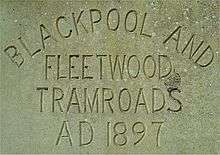 Headstone from Bispham depot now at Crich
Headstone from Bispham depot now at Crich- A pre-upgrade tram-stop located on the Promenade
- Rigby Road Depot (engineering part)
- Centenary class tram (Promenade)
- Double-decker Jubilee class tram (Promenade)
 Illuminated tram No. 736 "HMS Blackpool" at Fleetwood
Illuminated tram No. 736 "HMS Blackpool" at Fleetwood Balloon tram passing the Norbreck Castle Hotel
Balloon tram passing the Norbreck Castle Hotel- Flexity 2 type tram No. 011 at Burlington Road West tram stop
External links
| Wikimedia Commons has media related to Blackpool tramway. |
Route map: